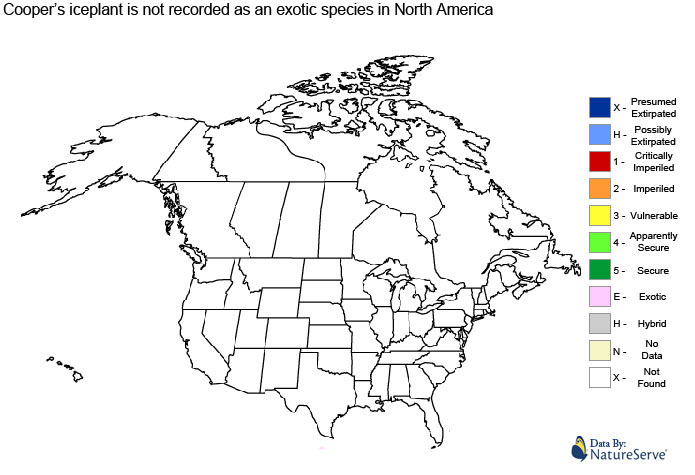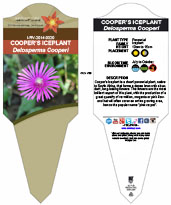

| Plant Name | Cooper's Iceplant | |
| Scientific Name | Delosperma Cooperi | |
| Family | Iceplant | |
| Plant Type | Perennial | |
| Start of Blooming Season | July | |
| End of Blooming Season | October |

| Soil Conditions | |
| Soil Moisture | |
| Sunlight | |
| Notes: |

The plant contains ramified stems that are spread out and are long and narrow, with the end of the stems increasing into a quantity of isolated small flowers, with diameters ranging from 3cm to 5cm. These abundant and long-lasting flowers will remain in bloom from July through September. The plant is sun-loving, and thrives well in very dry and hot environments. While it adapts well to various soil types, it will suffer under water stagnation, and thus prefers well drained soils, or even rocky terrain. The flowers of cooper's iceplant are violet to pink with many ray like pedals. Cooper's iceplant reproduces by seed or by plant cuttings.


No known health risks have been associated with cooper's iceplant. However ingestion of naturally occurring plants without proper identification is not recommended.

Cooper's iceplant can be referenced in certain current and historical texts under the following three names:
Cooper's iceplant can be translated into the following select languages:
| Arabic | مصنع الثلج | Bulgarian | лед за растителна | Chinese (Sim) | 冰厂 |
| Croatian | led biljke | Czech | led rostlina | Danish | |
| Dutch | Esperanto | glacio planto | Estonian | jää taim | |
| Finnish | French | fabrique de glace | German | Mittagsblume | |
| Greek | εργοστάσιο πάγου | Hebrew | מפעל קרח | Hungarian | jég növény |
| Italian | impianto di ghiaccio | Japanese | アイスプラント | Korean | 얼음 공장 |
| Punjabi | ਆਈਸ ਪੌਦਾ | Lithuanian | ledo gamykla | Norwegian | |
| Persian | کارخانه یخساز | Polish | Portuguese | fábrica de gelo | |
| Romanian | plantă de gheață | Russian | лед завода | Slovak | ľad rastlina |
| Spanish | planta de hielo | Swedish | is växt | Tagalog | |
| Turkish | buz çiçeği | Ukrainian | лід заводу | Vietnamese | nhà máy nước đá |

| The information provided in this conservation assessment has been provided by the Natureserve Database in conjuction with various federal, provincial, state, county, district, regional, and municipal governments as well as public and private conservation authorities. Information in this section is accurate from the last time this article was updated. | |
 |
Cooper's Iceplant has no conservation status as it is considered an exotic and or invasive species in North America. |

 |

 |
The MIROFOSS database offers free printable garden tags for personal and non-profit use. These tags can be used to properly identify plant samples in a garden. Click on the tags shown on the the screen or -click here- to download a full size jpeg image for a cooper's iceplant identification tag; which can be printed on paper or used with a plastic laser printer. |
 |
What's this? What can I do with it? |

| Description | Leistner, O. A. (ed.). 2000. Seed plants of southern Africa: families and genera. Strelitzia 10. National Botanical Institute, |
| Description | Smith, G. F.; Chesselet, P.; Van Jaarsveld, E. J.; Hartmann, H.; Hammer, S.; Van Wyk, B.-E.; Burgoyne, P.; Klak, C.; & Kurzweil, H. 1998. Mesembs of the world. Briza Publications, |
| Image Rendering | USDA-NRCS PLANTS Database / USDA NRCS. Wetland flora: Field office illustrated guide to plant species. USDA Natural Resources Conservation Service. |
| Environment | National Audubon Society. Field Guide To Wildflowers (Western Region): Alfred A. Knopf.ISBN 0-375-40232-2 |
| Physical Identification | National Audubon Society. Field Guide To Wildflowers (Western Region): Alfred A. Knopf. ISBN 0-375-40232-2 |
| June 06, 2015 | The last time this page was updated |
| ©2021 MIROFOSS™ Foundation | |
 |